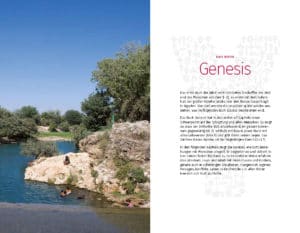by NEIL VANEY
A serious critique of Christianity – a critique that began in the 1960s – was that it was largely responsible for the ecological degradation of our planet. The argument ran like this: because earth is portrayed as just a waiting room for entrance to heaven, how to treat the planet is of little importance in the long run – earth’s only purpose is to provide for human needs till Christ comes again. One of the aims of Laudato Si’ is to show that this is a complete travesty of the Catholic understanding of the true relationship between earth and humankind, which is one of symbiosis and interdependence.

A note introduces the Book of Genesis in the illustrated “Youth Bible for the Catholic Church.” The Bible study guide includes a preface by Pope Francis, who write about his treasured old, “beat up” Bible and explains to young people how he prays with it. The guide was released by the Germany-based Katholisches Bibelwerk and the YouCat Foundation. Other language versions are expected in 2016. (CNS) See POPE-YOUTHS-BIBLE Dec. 3, 2015.
The Scriptural Basis of the Earth/Human Relationship
It is easy to overlook the significance of Genesis 2:7, “God formed man out of the clay of the ground.” The first human’s name was Adam; the Hebrew word for ground is adama. No matter how clever, how creative and important each of us may become, in time our body will break down into the elements that made it up. To maintain that body, we must labour; such work was meant to be a partnership with earth. God puts Adam in an enclosed garden “to cultivate and care for it”. (Genesis 2:15) This garden was rich in water and biodiversity. It was human weakness, and the dream of total independence, that led to the first couple being ejected from the garden into the hot and inhospitable lands of the Mesopotamian basin. This interpretation of the human condition is so different from those of the surrounding Sumerian cultures, where it is the gods, out of jealousy and spite, who inflict death and misfortune upon mankind.
Despite humanity’s rejection of the divine plan, God proposes a renewed relationship (covenant), of which the rainbow will be a sign of the everlasting pact, which is to be not just with humans but also with the rest of nature: “ I will see it (the rainbow) and recall the everlasting covenant that I have established between God and all living beings. (Genesis 9:16) The later prophets were so convinced of this relationship that they saw great calamities in the natural world as the outcome of Israel’s failure to observe the terms of the covenant – worship of the one God only. “Therefore, the land mourns, and all who dwell in it languish, the beasts of the field and even the fish of the sea are taken away.” (Hosea 4:3)
The Human Paradox – Creatures of Clay and Spirit
Despite many flirtations in the Church’s history with the Platonic idea that the human soul is a spiritual essence trapped within an alien body, the Church has always come back to the belief that spirit and matter are integrated realities in humankind – we are embodied spirits or, to put it the other way round, spirit-animated bodies.
This conviction that we are completely rooted in, and dependent on, our earth-based bodies has been reinforced by contemporary science. Simply to function our bodies need small amounts of metals like iron, chromium, manganese, molybdenum (and many others) that were formed in the superhot furnaces of second-generation stars before becoming part of our earth and then our bodies.
Our bodies are being constantly recycled and renewed as part of vast cycles driven by our delicately balanced atmosphere. The nitrogen cycle takes the inert gas from the air, allowing it to become part of our proteins and amino acids, just as the carbon cycle allows carbon to become part of the fuel that drives us day-by-day. It is the miracle of water that constitutes more than half of our body weight, as well as irrigating, cooling and making fertile our planet. If our spirits dance and leap up to greet God, it is possible only because of the earth that has become our muscles and our brains.
The Sacramental Nature of Catholic Faith
After the gigantic struggles over the Arian heresy in the third-fifth centuries, it became a central belief of Christian faith that Jesus Christ, though fully divine, was also completely human. There was also a gradually growing sense that his promise to be always with the Church was fulfilled in a twofold way. The first was through the invisible gifts of grace and forgiveness of sin; secondly, but equally, through visible markers of his power and presence in what came to be called sacraments and sacramentals.
So it came about that the action of water (cleansing), of oil (healing), of burning lights (vision) and bread (nourishment) were experienced and acknowledged as carrying the presence and power of God when administered within the Church’s continuing mission. As this sense grew and deepened, it became clearer that the beauty, the order and the rich diversity of the creatures of earth bring near the infinite goodness and mercy of the invisible Godhead.
Our next reflection on the spirituality of Laudato Si’ will explore this dimension. We conclude with this observation, that the link between the invisible God and the God-touched face of nature becomes clear to us as we deepen our sense that the nature of each human person is to be a bridge between spirit and matter.
- Fr Neil Vaney, SM, is pastoral director of The Catholic Enquiry Centre NZ. This is the second of four reflections by Fr Vaney on Laudato Si’ published in NZ Catholic. The next two will be published in August and September.
Reader Interactions